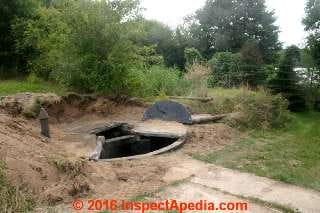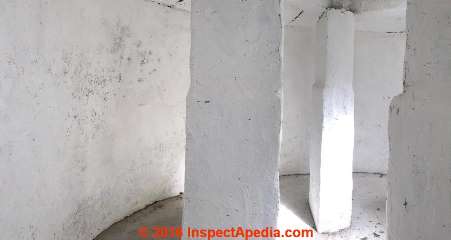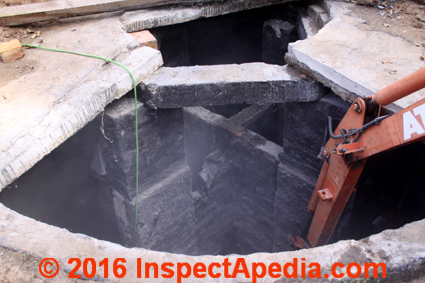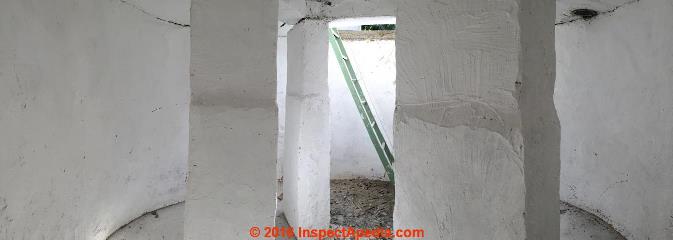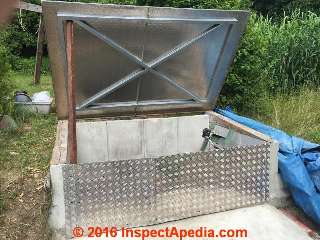 Concrete Septic Tanks
Concrete Septic Tanks
Inspect, Repair, or Re-Use Concrete Septic Tanks
- POST a QUESTION or COMMENT about concrete septic tanks: special problems, inspection, installation, troubleshooting, repairs, age, durability
Concrertre septic tank guide to installation, inspection, repair.
Page top photo: a concrete septic tank during installation at a New York home. Note that the concrete D-box has not been placed and instead is resting atop the septic tank awaiting its turn.
This document describes how to inspect the condition of a septic tank, providing special considerations for inspecting concrete septic tanks. Inspecting concrete septic tanks is a key component in onsite wastewater disposal systems.
InspectAPedia tolerates no conflicts of interest. We have no relationship with advertisers, products, or services discussed at this website.
- Daniel Friedman, Publisher/Editor/Author - See WHO ARE WE?
Guide to Concrete Septic Tanks: properties, sizes, installation, maintenance, repair
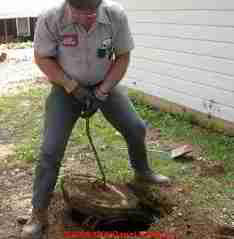
The photo shows a round concrete septic tank cover being removed to prepare for pumping a concrete septic tank. This is a safe cover and is rated thick enough to be driven-over by a car - but we do not recommend that practice.
Of course the area is quite unsafe while the septic tank cover is off - we would not leave the tank cover off and the area unattended. Concrete septic tanks at an existing septic installation are usually viable, but might have damaged baffles or cracks that permit seepage of groundwater in or septic effluent out around the tank.
Article Contents
- SEPTIC TANK INSTALLATION, CONCRETE
- CONCRETE SEPTIC TANK DAMAGE
- CONCRETE SEPTIC TANK REPAIRS
- CONCRETE SEPTIC TANK CONVERT to OTHER USES
Concrete Septic Tank Installation
[Details in process, contributions, questions, suggestions are welcomed - Ed. ]
Typical septic tank installation guidelines address testing the tank for water tightness, excavation procedures, tank placement, and backfill.
The concrete septic tank installation procedures shown here are adapted from various U.S. septic system codes, beginning with specific advice for concrete septic tanks.
Concrete Septic Tank Construction
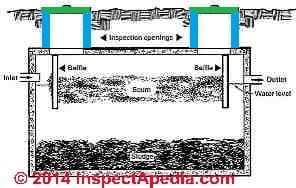 Concrete Septic Tanks
Concrete septic tanks shall be constructed in accordance with recommendations of the
American Concrete Institute (ACI) or an approved equal.
Concrete Septic Tanks
Concrete septic tanks shall be constructed in accordance with recommendations of the
American Concrete Institute (ACI) or an approved equal.
A study by the U.S. Public Health Service (1) was made on concrete septic tanks ranging in age of field use from one-half to 39 years. Of the 150 tanks inspected, 91% were judged to be in good or excellent condition with respect to the concrete with some showing corrosion at and above the water line
Various coatings have been applied to the interior of the septic tank above the operating water level but have shown little success in reducing corrosion. - FL DEP cited below
Test the Concrete Septic Tank Before Installation
- To insure water tightness, septic tanks shall be tested by filling with water to the soffit, left standing for twenty-four hours and examined for leakage. This is most important when installed in an area of high groundwater.
- Concrete septic tanks will usually require only testing of a representative
sample by the manufacturer. - FL DEP cited below
Concrete Septic Tank Installation Procedure
- Concrete eptic tanks shall be installed in accordance with the sound engineering practice.
- The excavation backfill adjacent to the installed concrete septic tank should be placed in 150 mm (6 inch) lifts watered to optimum and compacted to 90% of relative density.
- Stones or debris having a diameter of 102 mm (four inches) or larger should not be included in the backfill material.
- Backfill in the vicinity of the concrete septic tank inlet and outlet piping should be manually placed and consist of crushed rock to a depth of 150 mm (6 inches) over the inlet or outlet pipes with the remaining backfill placed in the same manner as adjacent to the septic tank.
- Concrete septic tanks installed in soft or yielding soils should be bedded on crushed rock having a thickness of not less than 150 mm (6 inches).
- When concrete septic tanks are installed in areas where groundwater will be above the septic tank floor the septic tank shall be secured against floatation. - FL DEP cited below
Concrete Septic Tank Risers/ Wetwell Covers
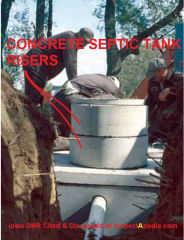 If the soil cover depth over the septic tank is more than a few inches (varying by jurisdiction) you should install a septic tank riser to permit easy and safe access to the septic tank cleanout openings.
If the soil cover depth over the septic tank is more than a few inches (varying by jurisdiction) you should install a septic tank riser to permit easy and safe access to the septic tank cleanout openings.
Photo: Two concrete rings form the riser over a concrete septic tank described in Iowa's residential wastewater treatment guide cited below.
The septic tank riser or wetwell and its cover for a concrerte septic tank may be made of formed or pre-cast concrete or of steel or plastic.
Septic tank risers and wetwell covers shall be secured to preclude desired removal, but be provided sufficient clearance to vent hydrostatic pressure should a check valve fail and backflow enter the tank, unless other forms of pressure relief are provided.
Unauthorized removal of the septic tank riser or wetwell covers should be discouraged through use of a tamper-resistant construction or locking device. - FL DEP cited below
See details
Concrete Septic Tank Installation Guides
- Florida DEP, DESIGN AND SPECIFICATION GUIDELINES
FOR LOW PRESSURE SEWER SYSTEMS [PDF] (1981) - retrieved 2022/04/25, original source: https://floridadep.gov/sites/default/files/guide_lowpres.pdf
Excerpts given above. - Iowa RESIDENTIAL ONSITE WASTEWATER TREATMENT - An Overview [PDF], Iowa DNR, retrieved 2022/04/25 original source: https://www.iowadnr.gov/Portals/idnr/uploads/water/septic/files/treatoverview.pdf
- US EPA SEPTIC TANK SYSTEMS for LARGE FLOW APPLICATIONS [PDF] (2000) Decentralized Systems Technology Fact Sheet U. S. Environmental Protection Agency, retrived 022/04/25 original source: https://www3.epa.gov/npdes/pubs/septic_tank_large_flow_app.pdf
- US EPA, MANUAL of SEPTIC-TANK PRACTICE [PDF] U.S. Department of Health, Education, & Welfare, Public Health Service, retrieved 2022/04/25 original source: https://nepis.epa.gov/
- U.S. EPA, ONSITE WASTEWATER TREATMENT SYSTEMS MANUAL Top Reference: US EPA's Design Manual for Onsite Wastewater Treatment and Disposal, 1980, available from the US EPA, the US GPO Superintendent of Documents (Pueblo CO), and from the National Small Flows Clearinghouse. Original source http://www.epa.gov/ORD/NRMRL/Pubs/625R00008/625R00008.htm
- U.S. EPA, SEPTIC SYSTEM TANKS [PDF] U.S. EPA, retrieved 2022/04/25 original source: https://www3.epa.gov/npdes/pubs/septic_system_tank.pdf
- "International Private Sewage Disposal Code," 1995, BOCA-708-799-2300, ICBO-310-699-0541, SBCCI 205-591-1853, available from those code associations.
- "Manual of Policy, Procedures, and Guidelines for Onsite Sewage Systems," Ontario Reg. 374/81, Part VII of the Environmental Protection Act (Canada), ISBN 0-7743-7303-2, Ministry of the Environment,135 St. Clair Ave. West, Toronto Ontario M4V 1P5 Canada $24. CDN.
- New York State Department of Health, APPENDIX 75-A WASTEWATER TREATMENT STANDARDS - INDIVIDUAL HOUSEHOLD SYSTEMS , [PDF] New York State Department of Health, 3 February 2010, retrieved 3/1/2010, original source: https://www.health.ny.gov/regulations/nycrr/title_10/part_75/appendix_75-a.htm
- US EPA ONSITE WASTEWATER TREATMENT SYSTEMS MANUAL [PDF] Top Reference: US EPA's Design Manual for Onsite Wastewater Treatment and Disposal, 1980, available from the US EPA, the US GPO Superintendent of Documents (Pueblo CO), and from the National Small Flows Clearinghouse. Original source http://www.epa.gov/ORD/NRMRL/Pubs/625R00008/625R00008.htm Onsite wastewater treatment and disposal systems, Richard J Otis, published by the US EPA. Although it's more than 20 years old, this book remains a useful reference for septic system designers. U.S. Environmental Protection Agency, Office of Water Program Operations; Office of Research and Development, Municipal Environmental Research Laboratory; (1980)
- Manual of Septic Tank Practice, US Public Health Service's 1959.
Types of Damage Found at Concrete Septic Tanks
- Septic tank leaks & flooding: One of the most common problems found on concrete (and some other) septic tanks is tank flooding due to either a drainfield backup or due to surface runoff or groundwater entering the septic tank.
Water also leaks into septic tanks from poorly-sealed pipe connections, leaky septic tank risers, and leaky septic tank covers.
How do we know if the septic tank is flooded? We look inside the tank (Watch out for leaning over or falling into the tank - usually fatal) to see an abnormally high sewage level or signs of effluent overflowing the baffles or Tees.
See SEPTIC TANK LEAKS
and
See SEPTIC TANK LEVELS of SEWAGE
and
See SEPTIC TANK BACK FLOODING
Also
See SEPTIC DESIGN for FLOOD DAMAGE RESISTANCE - Cracks in concrete septic tanks: Concrete tanks can crack or sections may separate causing leaks with the result of not only improper disposal of effluent (wrong location) but also subverting an attempt at a septic loading and dye test since when the system is un-used the tank liquid levels drop abnormally.
Poorly-mixed concrete may also fail from spalling. Occasionally we've seen tanks made of poor-quality concrete (insufficient portland cement) which eroded badly. If the tank outlet or absorption system have been blocked, examination of the tank interior may show that effluent is or has been above the top of the baffles (see "baffles" below) thus indicating a system failure.
The inspector may detect this condition only if there is a tank inspection port which is readily and safely accessible for before, during, and after inspection when running a loading and dye test. - Damaged or lost septic tank baffles: while concrete, properly mixed and set, is quite durable, in some concrete septic tank installations we find cracked, broken, crumbled, or even totally-lost baffles.
Without proper inlet and outlet baffles the septic tank sends solids to the drainfield or soakbed, much shortening its life; baffle loss at the tank inlet can lead to a sewer line blockage and sewage backup in the home.
Below we give links to septic tank baffle repair or replacement information. - Septic tank settlement: if not properly set on compacted soil, gravel, or another sound surface, a septic tank may settle or tip, causing poor operation or even leaks, blockages, broken pipes.
- Lost, missing, insecure septic tank access covers: permit someone to fall into the tank, usually fatal.
Watch out: be sure to keep people away from the area of a septic tank of unknown condition or that lacks a safe secure cover.
See SEPTIC TANK COVERS - Septic tank damage visible during or after pumping is discussed in detail in this article series:
SEPTIC TANK PUMPING PROCEDURE
Repairs to concrete septic tanks
Repairing damaged or lost concrete septic tank baffles
On occasion we find that the baffles at inlet or outlet ends of a septic tank have deteriorated, usually due to poor original concrete mix, and occasionally due to mechanical damage. A lost or damaged baffle at a septic tank is asking for sewage backup into the building or the passage of solids into the drainfield - substantially shortening its life.
To repair or replace a damaged septic tank baffle,
And
see SEPTIC TANK TEES
Repairing leaks into a concrete septic tank
Besides leaks due to a crack in a concrete septic tank, we find leaks into the tank due to improperly algined or placed entry or exit piping or missing, damaged gaskets at those locations. To repair septic tank leaks
see SEPTIC TANK LEAKS.
In addition to sealing openings at tank piping and cracks or holes (described below) if your septic tank is being flooded from local groundwater or surface runoff, the flooded tank will also flood the drainfield or may cause a sewage back-up into the building.
Some readers have suggested sealing the septic tank covers and access ports - but these need to be removable for service or repair, and really you may be treating the symptom, not the problem.
We agree that faced with a high cost of site drainage corrections, sealing the septic tank lid may be an appealing solution. First make sure that the flooded septic tank is due to surface runoff or groundwater, not a backing-up or failed drainfield, or you're simply fixing the wrong problem.
It makes sense to direct surface runoff away from the septic tank, or if necessary, install an intercept drain to keep ground water and surface water away from the tank.
Reparing cracks & holes in a concrete septic tank
It is possible to repair a crack or hole in a concete septic tank using concrete patching compounds and some foundation repair compounds, epoxies, and crack sealers. Key considerations are
Watch out: Safety - never enter a septic tank without special training, equipment, and assistance as gases are likely to be quickly fatal even if the tank has just been pumped and washed out
Concrete surfaces to be patched need to be clean of sewage and dirt or debris, and for some patch products, dry as well
See both SEAL CRACKS in CONCRETE, HOW TO
and SEAL CRACKS by POLYYREHTHANE FOAM INJECTION
How to Convert a Concrete Septic Tank for Other Uses
Question: convert a concrete septic tank into a room, shed, boat house or other use - East Germany
2007/10/14 I live in the former East Germany and stumbled upon your excellent website about septic tanks.
I have a really disgusting question for you but I think I have to give you one or two sentences of context first: We live on a lake deep deep in a forest which is a nature reserve and we are not allowed to build any new structures.
We are just having a biological septic system installed which purifies waste through a series of chambers (the second of which has special plants,...).
We were debating about whether to collapse and fill the old huge spetic tank (about 6 feet high X 10 feet wide X 15 feet long) or whether to remove it. A friend suggested that we CONVERT it into a room or a shed or a boat house or a wine cellar or something.
At first we laughed but now we have been wondering if that would even be possible. It is located under our lawn which ends with a steep bank overlooking the lake so it would be easy to access the "room" via a door from the lake side.
So my question is whether you think that it would be possible to clean the old (cement) tank well enough and then treat/paint, etc. the walls such that in the end it would be safe a healthy to actually go in there?
I can't picture having this as a guest room "Oh yes, this is under the lawn because it used to be the septic tank, sleep well!" but I can imagine using it as a shed for our tools or a place to store the boats --
Lord knows no one would steal the stuff because who would think to look for a shed under the lawn!! I would greatly aappreciate your brief take on the idea. - Regards, Anonymous by private email
Reply: steps in cleaning and preparing a used septic tank for other purposes
Above: nearing completion in 2016, this East German concrete septic tank has been cleaned and sealed to permit re-purposing it as an underground storage facility. The concrete pillars left in place help protect against a collapse of the septic tank cover.
It sounds worth trying - but
Watch out: BE CAREFUL Do not ever enter a septic tank, new or old - there could be fumes that can kill you quickly
To convert a septic tank to some other storage or possibly occupancy use you'd need to be sure it is clean, safe to enter, and sound; you'll also need to be sure you are successfully keeping surface runoff or groundwater from entering the tank.
- remove the tank cover
- open the end of the tank facing to outdoors and downhill
- power-wash the tank interior
- disinfect all surfaces
- coat or paint with a sealant and top coat
- perhaps using a bactericide in your paint coating
and also
- direct suface runoff away from the septic tank entry or opening
- provide a safe easy means of entry and exit
If the costs of all of these steps, including probably adding additional windows for light and ventilation make all of this worth the trouble it's worth considering. But I wonder if it wouldn't be less costly to collapse and remove the remains of the tank and build something a bit larger and more comfortable.
Any mistake could certainly make someone sick so be thorough. You could probably take some bacterial sample swabs from the interior surfaces and have them checked for bacterial level by a local lab to be sure the surfaces are safe. Let me know what happens, and send along photos if you try this project - I may be able to make other suggestions.
Reader follow-up: 2007/10/22
Since writing to you I had been considering removing the old tank and replacing it with a new one (basically, the same suggestion you made). We'll look into costs of getting or building something new (and maybe a little bigger) and of doing the steps you suggested and then decide. It won't be until Spring and I will write again and let you know what we do (including photos). Once again, I very much appreciate your taking your time to advice!
Reader follow-up: 2009/10/02 Septic tank converted to outdoor storage space
Maybe you remember me. I wrote to you almost 2 years ago to ask for your opinion about the idea of converting a large septic tank into a storage cellar and you kindly replied with some suggestions.
Well here we are 2 years later and fairly close to completion and at this point I am thinking and feeling that this was a good idea after all!
The new biological septic tank was up and running last summer so the old septic tank was empty over the winter. A few months ago, we took the dirt off part of the top of it to figure out exactly how big it actually is and thus access the feasibility of the conversion. It is pretty large but positioned in a way that made uncovering half of the roof and later accessing it via a door and spiral staircase -- not hard.
So, we decided to proceed. As the tank was emptied last summer when we switched to the new system, it did not smell bad. The sanitation guys came and power cleaned it well and measured the gasses with their meters and found zero bad gasses. It was baking sunny hot for several weeks and we left the tank open so it could thoroughly air out.
The sanitation guys here said that it takes 30 days to be sure that all bacteria are dead. It's been open and empty a lot longer than that now. (I will still probably take a culture to a lab at the end before we start really going down there and touching the walls, etc.).
Next, we removed the interior walls with the exception of the support posts and a 20" cross in the middle that further support the support posts and keep them from shifting. That's where we are now. It is really a good size now that I see it = The ceiling is a generous 7 feet up and it is (round) just over 12 feet in diameter.
We plan to use it to store all our annoying stuff like extra fence materials and garden tools, as well as possibly for a small wine cellar.
Our East German friends (who were very used to creatively improvising and rigging things to work with odd materials and strange substitutions -- under the old East German system) have lots of ideantergarden s and advice -- like, for example, using it as a refrigerator. Anyways, it was one of these guys who suggested converting it to begin with so I am more than happy to listen to their ideas!
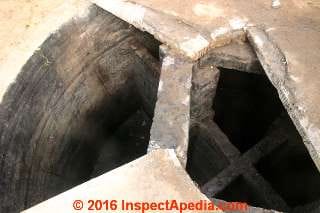
Last steps [ in septic tank conversion to occupied use ] now are to
1. install the spiral staircase along the wall and -- my husband's idea -- a PULLEY system for lowering and raising heavy items and to
2. paint it with a sealant and
3. add the walls over the opening and the access door with roof. Plus electricity.
I am attaching a few photos, as promised. First (9744) there is one that shows how the tank is positioned vis a vis the lawn and the driveway and the lake, etc. Then (9746) you can see what the internal structure looked like at first
. In photo 1842, you can see what it looks like with the internal walls removed but the support pillars left in place (in this photo, they are just shortening the cement cross in the middle of the structure so that it is just about 20" high instead of the 5 feet it was originally.
It is now perfectly easy to get around and bright enough and airy enough not to be horrible. Of course, the wall and door will eliminate a lot of the light and airiness but we are going to usé a transparent roofing material like wintergarden plastic or something.
All in all, it will have cost about 2500. for all the work (cleaning, knocking down the walls and installing the stairs and walls, etc.) and materials (paint/sealant and cement and wood and plastic whatever for the external walls/roof.
Removing this thing would have been cost-prohibitive and it would not have been possible to install something any bigger since we are talking about a space that is under our lawn!
Also, the nature preserve laws prohibit building something new.
So, I just wanted to follow-up as promised and send you some photos with an update. Thanks for your suggestions and well, now you know,.... not that I imagine that you will have hundreds of US customers wanting to follow-suit but with the current economic crisis,... who knows! I'll send you a final photo when the fence and door and roof are built and the interior is painted and all pristine looking, if you are interested.
Reader follow-up: 2016/06/02
I just happened upon your email from some years ago.
Maybe you remember me: I live in Germany and converted my old septic tank into a storage cellar.
I'm not sure if this email is still good for you but if you reply, I would be happy to send you a brief update and photos. We are glad we did this.
Reply:
Yes please do send along photos - as we've heard from several readers who have considered making alternative use of old septic tanks or other old concrete, fiberglass, or plastic structures.
Reader follow-up on conversion of an East Germany septic tank to usable space: 2016/06/04
- We just put an electric cable in so we can have an outlet, a light and an electric ladder. And we are just fixing the door. Should be done with these things next week or so.
Update since 2009:
- We do a lot of natural building using cob (sand, clay and straw) and earthen plasters so, last year, we put a bright tan earthen plaster over the old tar walls and ceiling. It looked great for a few days but was very quickly covered with grey and black mold. So I ordered a wonderful natural product from the US called LimePrime which immediately eliminates and prevents all mold. So now it smells super fresh and is bright white.
- Poured a new cement floor.
- Installed a ladder with a platform that rolls up or down (this has a hand crank but we want to replace It with an electric motor).
- Built cement walls around the opening and an aluminum entrance (not sure what this type of door is called in English.
- Maybe I will send a few photos today and some after the final finishes.
- Anon. 2016/06/04
Update: 2016/07/18: below is the cleaned, sealed interior of this concrete septic tank converted to an underground storage facility:
Below: seen from above-grond is a diamond-plate hinged cover assembly providing access to the underground storage facility converted from the re-purposed septic tank.
Remaining tasks include installation of gas charged lift supports to make opening the access cover easy and safe, and perhaps a security lock to keep the underground storage room child-safe.
...
Reader Comments, Questions & Answers About The Article Above
Below you will find questions and answers previously posted on this page at its page bottom reader comment box.
Reader Q&A - also see RECOMMENDED ARTICLES & FAQs
On 2021-02-18 - by (mod) -
Not if the opening and pipe connection are properly located and protected by a baffle or tee
On 2021-02-18 by Bob
Is a septic tank been compromised if another hole has been installed for a 4” pipe
On 2020-11-04 - by (mod) -
If that's a concrete tank you probably can remove the loose concrete and use a concrete patching compound to make a good repair
On 2020-11-04 by Anonymous
Wall of tank deterioratingat drain pipe
On 2020-07-23 by Al
I have an old concrete septic tank with a concrete slab top. One corner of the lid cracked and fell into tank leaving a hole in one corner. Was told by contractor that was not a problem and put an outdoor sprinkler box to cover the hole so it would be easier to pump out.
Problem with sewer fly’s, could this be because the top is not sealed?
On 2020-05-15 - by (mod) -
Jim
If we're talking about a concrete lid then prybars and a couple of flat bars may work
and softening the tar with a mineral-based solvent might help, (show me a photo)
but
Watch out: never work alone, never lean over the open septic tank - you can become overwhelmed by methane gas fumes and fall in - to a quick and nasty death.
On 2020-05-15 by Jim
My septic tank access lid has been sealed on with what looks like tar. How can I get this off so I can pump and inspect the tank? I’ve been digging at the tar for a day and a half and it still won’t budge. They kid has a plastic handle and that broke.
On 2020-02-25 - by (mod) -
Art
In the ARTICLE INDEX (given near the end of each article) we find SEPTIC DRAINFIELD SIZE https://inspectapedia.com/septic/Septic-Drainfield-Size.php
That's where you should start.
Keep in mind that it's not just the number of bedrooms or total daily wastewater volume that determine septic drainfield size.
Everything depends on the soil percolation rate.
On 2020-02-24 by ART STANFIELD
What size drainage field is required for a 1000 ceptic tank with 3 bedroom home?
On 2018-03-16 by (mod) - crack or leak in a waste line under a home could release both sewage and sewer gases
Bruce
A crack or leak in a waste line under a home could release both sewage and sewer gases under a home. I would try a careful inspection of the sewer line interior by a sewer camera. If there is damage it's likely to be visible either as a crack/dislocation in the piping or as soil entering the waste line.
On 2018-03-16 by Bruce W Bryant
Is it possible you got a full in Maine going to septic tank that it could be damaged during an earthquake
I live in Virginia in 2011 we had a earthquake and I can't seem to find the smell coming from my under my house and my septic tank is all been checked at and good I'm just wondering the 4-inch pipe in the ground
could it be causing a problem or leaking where you don't see Water Rising but over time with winds restricting the air flow out of the vent pipe up there Northwest winds I get the heist gets full of natural gas is underneath I got a 24 by 48 foot has made in 1956 but I have done everything but dig up a pipe and get someone to come in here and dig up a 4-inch pipe that goes to the
On 2017-10-19 by George
Hello,
I noticed that I have some leakage at the location where the plastic riser sits on the concrete tank. I know that butyl sealing tape was used during the install but obviously the seal is not perfect.
Preference would be to seal on the outside of joint but since riser is approx. 18" in soil, I thought of sealing the inside of the joint where the riser and tank meet. I thought of using a product call Wet-R-Dri plastic roof cement that is made for roofing leaks around chimmneys, roof vents,
and states it is good for underground water-proofer and damp-proofer. It is a tar like material that appears would stick to both materials. Is this something you would recommend or do you recommend something else?
On 2017-01-28 by LadyGray
@Alarson,
Sounds as though it was not pumped out.
On 2017-01-05 by (mod) - Pumping the septic prior to sale, of course, will prevent any actual test
Pumping the septic prior to sale, of course, will prevent any actual test of the condition of the drainfield unless such a test was performed before the tank was pumped.
Inspecting a septic tank, if competently performed, would certainly include a comment on the materials and condition of the tank including the safety of its cover - perhaps the most-important consideration when you realize that usually falling into a septic tank is quickly fatal.
In my OPINION, if the cover of the tank was thin steel that alone would have been enough for a warning, regardless of its apparent condition.
If the tank cover and lids were concrete, then something else has to explain the collapse. A damaged cover, mis-placed cover, wrong-sized or shaped cover, etc.
I would need to know quite a bit more about the materials and condition of the septic tank to have an authoritative opinion. But those are my thoughts.
On 2017-01-05 by Alarson - I inadvertently stepped over the septic tank lid and slipped up to my thigh in septic nastiness.
I just bought a home built in 1984. Septic was accessed, inspected and pumped prior to sale. Concrete lids over double chamber septic. Inspection stated everything was fine. Fast forward to this week (just four months after this inspection)
I inadvertently stepped over the access lid and slipped up to my thigh in septic nastiness. I wasn't hurt and am lucky it was me not my toddler who I was carrying. The area is not driven over or even walked on very often...In a side garden.
The company that did the inspection swears that something must have happened in the last four months to cause lid to fail and takes no responsibility. They are coming tomorrow to do $400 installation of risers and new lids. Does this sound right? Would some negligence have caused the lid to fail? Or is it just bad luck?
On 2017-01-01 by (mod) - concrete lid fell into the tank
Matt:
Watch out: do not ever enter a septic tank to try to clean or repair it unless you have the right training and safety and breathing and rescue equipment as well as a crew standing by to pull you out. Failure to follow that advice is likely to result in your death.
On 2017-01-01 by matt
When you are repairing a cracked cement septic tank built 15 years ago the concrete lid fell into the tank in overtime it begin to feel sludge thick sludge
can I possibly take too much too quick I believe I need to take my time and use a shovel because I believe the tank surrounding is solid but now you have to bring in heavy equipment to use a 14 to 16 inch bucket just trying to help homeowners save money
On 2016-10-02 by (mod) - Never enter a septic tank nor even lean over a septic tank unless you are trained and have the proper equipment
Watch out! Never enter a septic tank nor even lean over a septic tank unless you are trained and have the proper equipment and also have assistance. Never work alone. There are serious risks of dying from asphyxiation.
There are of course many concrete patching compounds and also Coatings that can be painted on the concrete before using a patching compound to improve adhesion to a clean sound concrete surface. However if the concrete mix that was used to make the tank was poor to start with, I would be concerned about spending for a very expensive repair requiring special training and Equipment only to find that the repair isn't durable because the tank continues to disintegrate. Therefore you need a decent evaluation on the condition of the tank and where they repair make sense.
On 2016-10-02 by Floyd repair a crumbling portion of the center wall in a septic tank
I am wondering if it is possible to repair a crumbling portion of the center wall in a septic tank. I have a very distinct line of crumbling/concrete erosion in this center divide wall. I wonder if there is a product that could be spread over the area to protect the existing concrete from getting any deeper of the erosion that is happening.
Changing out the tank is extremely difficult due to location of the tank. The remainder of the tank isnt in that bad of shape. The damage is a V shaped erosion pattern beginning at the pipe from the primary side to the secondary side. The damage is in the secondary side well above the high water level where the pump kicks in.
The damage goes down in a V pattern and is quite deep almost as if you held a water sprayer on it for 20 yrs or more to cut into the concrete. Would love to here your thoughts on this issue. I am in Alberta Canada
On 2016-05-13 by (mod) - "best septic design" -
Anon:
I don't think there is a single "right answer" or "best septic design" - the system needs to be chosen and designed to fit the site (available area, slopes, soil properties, wastewater usage). Unfortunately there's no magic bullet.
Aerobic septic systems are appealing because of their high level of treatment of wastewater but, then, the no. 1 cause of aerobic system failure is lack of maintenance: they need more attention. Beware of "magic bullet" fixes or designs.
On 2016-05-12 2 by Anonymous
What is the best type of septic system and is the concrete tank the best type?
On 2015-11-10 by (mod) - repair or replace: both septic tank lid options are possible;
Judy, repair or replace: both septic tank lid options are possible; but if your tank lid can be lifted off and replaced that will probably be faster and easier; Give your local septic tank company a call to ask for a bid.
Consider that in either case the top of the tank has to be exposed, so that labor ought to be the same; and the cost of having to build a form, cast a new reinforced top atop the existing one (to be sure the new cover is safe against a fatal fall-in), and provide replacement access covers may be more than the cost of removing and disposing of the old lid and placing a new one in place.
On 2015-10-18 by Judy
Is it possible to repair concrete top of Septic tank? There are cracks in it. Just cleaned out.
On 2015-02-10 by (mod)
Sergio
In the ARTICLE INDEX please see SEPTIC TANK SIZE
On 2015-02-07 by Sergio
How many septic tanks do you need on a 3 bed room 2.5 bath home in the state of texas per code. Also how many gls. should they be.
On 2014-06-02 by (mod) - are residential concrete sewers or septic tanks legal in Vermont?
Pam if I understand the question it's not whether or not private septic systems are legal (they are but must comply with code), but whether concrete septic tanks are legal? Sure.
On 2014-06-02 1 by Pam
are residential concrete sewers or septic tanks legal in Vermont
...
Continue reading at SEPTIC TANKS, FIBERGLASS / PLASTIC or select a topic from the closely-related articles below, or see the complete ARTICLE INDEX.
Or see these
Recommended Articles
- CONCRETE CORROSION DUE TO HYDROGEN SULFIDE
- SEPTIC TANKS - home
- SEPTIC TANK BACK FLOODING
- SEPTIC TANK BAFFLES
- SEPTIC TANK CAPACITY VS USAGE in Daily Gallons of Wastewater Flow, calculating required septic tank size, calculating septic tank volume from size measurements
- SEPTIC TANK COVERS
- SEPTIC TANK DEPTH
- SEPTIC TANK DESIGN DEPTH
- SEPTIC TANK DESIGN SPECIFICATIONS
- SEPTIC TANK DESIGN STRENGTH SPECS
- SEPTIC TANK, HOW TO FIND
- SEPTIC TANK INSTALLATION - home
- SEPTIC TANK, DRAINFIELD INSTALLATION - from BUILD YOUR DREAM HOME
- SEPTIC TANK INSTALLATION, CONCRETE
- SEPTIC TANK RISERS
- SEPTIC TANK SAFETY
- SEPTIC TANK SIZE
- SEPTIC TANK TEES
Suggested citation for this web page
SEPTIC TANKS, CONCRETE at InspectApedia.com - online encyclopedia of building & environmental inspection, testing, diagnosis, repair, & problem prevention advice.
Or see this
INDEX to RELATED ARTICLES: ARTICLE INDEX to SEPTIC SYSTEMS
Or use the SEARCH BOX found below to Ask a Question or Search InspectApedia
Ask a Question or Search InspectApedia
Questions & answers or comments about concrete septic tank construction, selection, installation, troubleshooting & repair..
Try the search box just below, or if you prefer, post a question or comment in the Comments box below and we will respond promptly.
Search the InspectApedia website
Note: appearance of your Comment below may be delayed: if your comment contains an image, photograph, web link, or text that looks to the software as if it might be a web link, your posting will appear after it has been approved by a moderator. Apologies for the delay.
Only one image can be added per comment but you can post as many comments, and therefore images, as you like.
You will not receive a notification when a response to your question has been posted.
Please bookmark this page to make it easy for you to check back for our response.
IF above you see "Comment Form is loading comments..." then COMMENT BOX - countable.ca / bawkbox.com IS NOT WORKING.
In any case you are welcome to send an email directly to us at InspectApedia.com at editor@inspectApedia.com
We'll reply to you directly. Please help us help you by noting, in your email, the URL of the InspectApedia page where you wanted to comment.
Citations & References
In addition to any citations in the article above, a full list is available on request.
- New York State Department of Health, APPENDIX 75-A WASTEWATER TREATMENT STANDARDS - INDIVIDUAL HOUSEHOLD SYSTEMS , [PDF] New York State Department of Health, 3 February 2010, retrieved 3/1/2010, original source: https://www.health.ny.gov/regulations/nycrr/title_10/part_75/appendix_75-a.htm
- US EPA ONSITE WASTEWATER TREATMENT SYSTEMS MANUAL Top Reference: US EPA's Design Manual for Onsite Wastewater Treatment and Disposal, 1980, available from the US EPA, the US GPO Superintendent of Documents (Pueblo CO), and from the National Small Flows Clearinghouse. Original source http://www.epa.gov/ORD/NRMRL/Pubs/625R00008/625R00008.htm
- Water Wells and Septic Systems Handbook, R. Dodge Woodson. This book is in the upper price range, but is worth the cost for serious septic installers and designers.
Quoting Amazon: Each year, thousands upon thousands of Americans install water wells and septic systems on their properties. But with a maze of codes governing their use along with a host of design requirements that ensure their functionality where can someone turn for comprehensive, one-stop guidance? Enter the Water Wells and Septic Systems Handbook from McGraw-Hill.
Written in language any property owner can understand yet detailed enough for professionals and technical students this easy-to-use volume delivers the latest techniques and code requirements for designing, building, rehabilitating, and maintaining private water wells and septic systems. Bolstered by a wealth of informative charts, tables, and illustrations, this book delivers:
* Current construction, maintenance, and repair methods
* New International Private Sewage Disposal Code
* Up-to-date standards from the American Water Works Association - Wells and Septic System, Alth, Max and Charlet, Rev. by S. Blackwell Duncan, $ 18.95; Tab Books 1992. We have found this text very useful for conventional well and septic systems design and maintenance --DF.
- The NSFC Products List has an excellent list of design manuals/modules National Small Flows Clearinghouse (NSFC) now (2019/12/13) hosted at http://www.nesc.wvu.edu/ Tel: 304-293-4191 e-mail info@mail.nesc.wvu.edu.
he National Small Flows Clearinghouse (NSFC) was funded by the U.S. Environmental Protection Agency (EPA) to help America's small communities and individuals solve their wastewater problems through objective information about onsite wastewater collection and treatment systems. NSFC products and information are the only national resource of its type, dealing with small community wastewater infrastructure. or by telephone 800-624-8301 - In addition to citations & references found in this article, see the research citations given at the end of the related articles found at our suggested
CONTINUE READING or RECOMMENDED ARTICLES.
- Carson, Dunlop & Associates Ltd., 120 Carlton Street Suite 407, Toronto ON M5A 4K2. Tel: (416) 964-9415 1-800-268-7070 Email: info@carsondunlop.com. Alan Carson is a past president of ASHI, the American Society of Home Inspectors.
Thanks to Alan Carson and Bob Dunlop, for permission for InspectAPedia to use text excerpts from The HOME REFERENCE BOOK - the Encyclopedia of Homes and to use illustrations from The ILLUSTRATED HOME .
Carson Dunlop Associates provides extensive home inspection education and report writing material. In gratitude we provide links to tsome Carson Dunlop Associates products and services.


